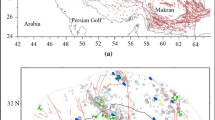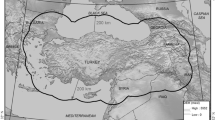Abstract
Recent earthquake damage distributions have demonstrated that the influence of local geology on ground shaking is a significant factor in engineering seismology. So, calculating the site effect is a priority to get a trustworthy assessment of the seismic risk for a location, in addition to studying the local seismic sources. The signal amplitude can be amplified by this effect throughout a range of periods. The site effect has been calculated using a variety of computational and experimental techniques, such as seismic noise measurements. In this study, to calculate the site effect, the analysis of accelerograms recorded by Iran’s strong motion network of the Road, Housing, and Urban Development Research Center was used. Here, 294 records from 63 stations were used to calculate the H/V (horizontal to vertical spectral ratio) curve as well as the near-surface high-frequency attenuation parameter (κ0). The classification method is based on determining the peak period at each station. To examine site effect consideration, we use the hybrid method composed of the finite difference method for low frequencies (< 1 Hz) and a stochastic finite fault method for high-frequency radiation (> 1 Hz) to simulate an earthquake scenario on the Niavaran fault, which is located north of Tehran, Iran. According to the findings, different site classes cause spectral amplitude variations ranging from 11 to 28% at different periods (T = 0.2, 0.5, 1.0, and 4.0 s).

















Similar content being viewed by others
Data availability
The data generated during the current study are available from the corresponding author upon reasonable request.
References
Abbassi MR, Farbod Y (2009) Faulting and folding in quaternary deposits of Tehran’s piedmont (Iran). J Asian Earth Sci 34:522–531
Ameri G, Gallovic F, Pacor F (2012) Complexity of the Mw 6.3 2009 L’Aquila (central Italy) earthquake: 2. Broadband strong motion modeling. J Geophys Res Solid Earth 117:B04308
Anderson J, Hough S (1984) A model for the shape of the Fourier amplitude spectrum of acceleration at high frequencies. Bull Seism Soc Am 74:1969–1993
Arian M, Bagha N, Khavari R, Noroozpoor H (2012) Seismic sources and neo-tectonics of Tehran area (North Iran). Indian J Sci Technol 5(3):2379–2383
Assatourians K, Atkinson G (2012) EXSIM12: A Stochastic Finite-Fault Computer Program in FORTRAN, http://www.seismotoolbox.ca. Accessed Nov 2014
Bard PY, Bora SS, Hollender F, Laurendeau A, Traversa P (2019) Are the Standard VS-Kappa host-to-target adjustments the only way to get consistent hard-rock ground motion prediction? Pure Appl Geophys 177(5):2049–2068
Berberian M (1976) Contribution to the Seismotectonics of Iran, Part II. Geol Surv Iran 39, 518p (in English) with five color maps
Berberian M, Yeats RS (1999) Patterns of historical earthquake rupture in the Iranian Plateau. Bull Seismol Soc Am 89(1):120–139. https://doi.org/10.1785/BSSA0890010120
Berberian M, Yeats RS (2001) Contribution of archaeological data to studies of earthquake history in the Iranian plateau. J Struct Geol 23:563–584
Beresnev I, Atkinson GM (1997) Shear wave velocity survey of seismographic sites in eastern Canada: calibration of empirical regression method of estimating site response. Seism Re S Lett 68:981–987
Bielak et al (2010) The ShakeOut earthquake scenario: Verification of three simulation sets. Geophys J Int 180:375–404. https://doi.org/10.1111/j.1365-246X.2009.04417.x
Bonnefoy-Claudet S, Cotton F, Bard P-Y (2006) The nature of noise wavefield and its applications for site effects studies. Earth-Science Reviews. https://doi.org/10.1016/j.earscirev.2006.07.004
Boore DM (1983) Stochastic simulation of high-frequency ground motions based on seismological models of the radiated spectra. Bull Seismol Soc Am 73:1865–1894
Boore DM (2003) Simulation of ground motion using the stochastic method. Pageoph 160(3):635–676. https://doi.org/10.1007/PL00012553
Boore DM (2009) Comparing stochastic point-source and finite-source ground-motion simulations: SMSIM and EXSIM. Bull Seismol Soc Am 99:3202–3216. https://doi.org/10.1785/0120090056
Boore DM (2005) SMSIM - Fortran programs for simulating ground motions from earthquakes: version 2.3 - a revision of OFR 96-80-A. U.S. Geological Survey Open-File Report 00-509
Boore D, Stewart J, Seyhan E, Atkinson G (2014) NGA-West2 Equations for Predicting PGA, PGV, and 5% Damped PSA for Shallow Crustal Earthquakes. 30:1057–1085. https://doi.org/10.1193/070113EQS184
Building and Housing Research Center (2014) Iranian code of practice for seismic resistant design of buildings, Standard No. 2800, 4th edn. Tehran, Iran
Davatgari Tafreshi M, Singh Bora S, Ghofrani H, Mirzaei N, Kazemian J (2022) Region- and site-specific measurements of kappa and associated variabilities for Iran. Bull Seismol Soc Am 112(6):3046–3062
Donner S, Roessler D, Krueger F, Ghods A, Strecker M (2013) Segmented seismicity of the M w 6.2 Baladeh earthquake sequence (Alborz Mountains, Iran) revealed from regional moment tensors. Journal of Seismology. 17. https://doi.org/10.1007/s10950-013-9362-7
BSSC (2000) NEHRP Recommended Provisions for New Building and Other Structures, Part 1: Provisions (FEMA 368). BUILDING SEISMIC SAFETY COUNCIL. Washington, DC
Fukushima Y, Bonilla LF, Scotti O, Douglas J (2007) Site classification using horizontal to vertical response spectral ratios and its impact when deriving empirical ground-motion prediction equations. J Earthquake Eng Taylor & Francis 11(5):712–724
Ghasemi H, Zare M, Fukushim Y, Sinaeian F (2009) Applying empirical methods in site classification, using response spectral ratio (H/V): a case study on Iranian strong motion network (ISMN). Soil Dyn Earthq Eng 29:121–132
Heaton TH (1990) Evidence for and implications of self-healing pulses of slip in earthquake rupture, Physics of the Earth and Planetary Interiors, 64(1). ISSN 1–20:0031–9201
Jackson J (2006) Fatal attraction: living with earthquakes, the growth of villages into megacities, and earthquake vulnerability in the modern world Phil. Trans R Soc A. 3641911–1925. https://doi.org/10.1098/rsta.2006.1805
Japan Road Association. “Specifications for Highway Bridges Part V, Seismic Design”, Maruzen Co., LTD, 1980
Japan International Cooperation Agency (JICA) (2000). “Centre for Earthquake and Environmental Studies of Tehran (CEST), Tehran Municipality: The Study on Seismic Microzoning of the Greater Tehran Area in the Islamic Republic of Iran”
Kanai K, Tanaka T (1961) On Microtremors VIII. Bullet Earthquakes Res Inst 39:97–114
Kinoshita S (1994) Frequency-dependent attenuation of shear wave in the crust of the southern Kanto area. Bull Seismol Soc Am 59:1387–96
Kristek, J., Moczo, P., 2014. FDSim3D - The Fortran95 code for numerical simulation of seismic wave propagation in 3D heterogeneous viscoelastic media. www.cambridge.org/moczo
Lee VW, Trifunac MD, Todorovska M, Novikova EI (1995) Empirical equations describing attenuation of peaks of strong ground motion, in terms of magnitude, distance, path effects and site conditions. University of Southern California (Report no. CE 95–02)
Lermo J, Chavez-Garcia FJ (1993) Site effect evaluation using spectral ratios with only one station. Bull Seismol Soc Am 83:1574–1594
Lussou PPY, Bard F, Cotton Y, Fukushima (2001) Seismic design regulation codes: Contribution of K-net data to site effect evaluation. J Earthq Eng 5:13–33
Mai PM, Beroza G (2003) A hybrid method for calculating near-source, broadband seismograms: application to strong motion prediction. Phys Earth Planet Int 137:183–199
Motaghi Kh, Ghods A (2012) Attenuation of Ground-Motion Spectral Amplitudes and Its Variations across the Central Alborz Mountains. Bull Seismol Soc Am 102(4):1417–1428. https://doi.org/10.1785/0120100325
Motazedian D (2006) Region-specific key seismic parameters for earthquakes in northern Iran. Bull Seismol Soc Am 96(4A):1383–1395
Motazedian D, Atkinson GM (2005) Stochastic finite-fault modeling based on a dynamic corner frequency. Bull Seismol Soc Am 95:995–1010
Mousavi M, Zafarani H, Noorzad A, Ansari A, Bargi K (2007) Analysis of Iranian strong-motion data using the specific barrier model. J Geophys Eng 4(4):415–428
Olsen K, Archuleta R (1996) Three-dimensional simulation of earth- quakes on the Los Angeles fault system. Bull Seism Soc Am 86:575–596
Olsen K, Akinci A, Rovelli A, Marra F, Malagnini L (2006) 3D ground-motion estimation in Rome, Italy. Bull Seismol Soc Am 96:133–146
Pitarka A, Takenaka H, Suetsugu D (1994) Modeling strong motion in the Ashigara Valley for the 1990 Odawara, Japan, earthquake. Bull Seism Soc Am 84:1327–1335
Rodriguez-Marek A, Rathje EM, Bommer JJ, Scherbaum F, Stafford PJ (2014) Application of single-station sigma and site-response characterization in a probabilistic seismic-hazard analysis for a new nuclear site. Bull Seism Soc Am 104(4):1601–1619
Sadeghi-Bagherabadi A, Sobouti F, Pachhai S, Aoudia A (2020) Estimation of geometrical spreading, quality factor and kappa in the zagros region, Soil Dynamics and Earthquake Engineering, Volume 133. ISSN 106110:0267–7261
Safak E (2001) Local site effects and dynamic soil behavior. Soil Dyn Earthq Eng 21:453–458
Shafiee A, Azadi A (2007) Shear-wave velocity characteristics of geological units throughout Tehran city, Iran. J Asian Earth Sci 29:105–115
Sinaeian, F (2006) Study on Iran strong motion records, PhD dissertation, International Institute of Earthquake Engineering and Seismology, Tehran, Iran
Somerville P, Irikura K, Graves R, Sawada S, Wald D, Abrahamson N (1999) Characterizing earthquake slip models for the prediction of strong ground motion. Seismol Res Lett 70:59–80
Yamazaki F, Ansary MA (1997) Horizontal-to-vertical spectrum ratio of earthquake ground motion for site characterization. Earthquake Eng Struct Dyn 26:671–689
Zafarani H, Noorzad A, Ansari A, Bargi K (2009) Stochastic modeling of Iranian earthquakes and estimation of ground motion for future earthquakes in Greater Tehran. Soil Dyn Earthq Eng 29(4):722–741
Zafarani H, Hassani B, Ansari A (2012) Estimation of earthquake parameters in the Alborz seismic zone, Iran using generalized inversion method. Soil Dyn Earthq Eng 42:197–218
Zare M, Bard PY, Ghafory-Ashtiany M (1999) Site characterizations for the Iranian strong motion network. Soil Dyn Earthquake Eng 18:101–123
Zarrineghbal A, Zafarani H, Rahimian M (2021) Towards an Iranian national risk-targeted model for seismic hazard mapping. Soil Dyn Earthq Eng. https://doi.org/10.1016/j.soildyn.2020.106495
Zhao JX, Irikura K, Zhang J, Fukushima Y, Somerville PG, Asano A (2006) An empirical site classification method for strong-motion stations in Japan using H/V response spectral ratio. Bull Seism Soc Am 96:914–925
Zhao JX, Irikura K, Zhang J, Fukushima Y, Somerville PG, Saiki T, et al (2004) Site classification for strong motion stations in Japan using H/ V response spectral ratio. In: 13th World conference of earthquake engineering. Vancouver, BC, Canada, 2004. Paper no 1278
Zhifeng Hu (2022) Kim B Olsen, Steven M Day, 0–5 Hz deterministic 3-D ground motion simulations for the 2014 La Habra California, Earthquake. Geophys J Int 230(3):2162–2182
Acknowledgements
This work was supported by the International Institute of Earthquake Engineering and Seismology. We would like to acknowledge Building and Housing Research Center that provided strong motion data. This study was supported by the International Institute of Earthquake Engineering and Seismology (IIEES), and is a part of the project: “Physics Based Probabilistic Seismic Hazard Analysis by considering uncertainties, case study: Tehran region.”
Author information
Authors and Affiliations
Contributions
Reza Alikhanzadeh: Material preparation, data collection, and analysis, simulation, writing the manuscript.
Hamid Zafarani: Discussed the results and commented on the manuscript and supervision.
Behzad Hassani: Discussed the results and commented on the manuscript.
Corresponding author
Ethics declarations
Ethics approval and consent to participate
Not applicable.
Consent for publication
Not applicable.
Competing interests
The authors declare no competing interests.
Additional information
Publisher's note
Springer Nature remains neutral with regard to jurisdictional claims in published maps and institutional affiliations.
Rights and permissions
Springer Nature or its licensor (e.g. a society or other partner) holds exclusive rights to this article under a publishing agreement with the author(s) or other rightsholder(s); author self-archiving of the accepted manuscript version of this article is solely governed by the terms of such publishing agreement and applicable law.
About this article
Cite this article
Alikhanzadeh, R., Zafarani, H. & Hassani, B. Site effect estimation in the Tehran basin and its impact on simulation results. J Seismol 27, 429–453 (2023). https://doi.org/10.1007/s10950-023-10149-5
Received:
Accepted:
Published:
Issue Date:
DOI: https://doi.org/10.1007/s10950-023-10149-5









